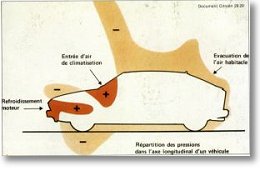 I am just beginning to understand why changing the intake path on my car provided such good performance gains. A thread on NASIOC thoroughly explores this, especially on pages 4 and 5 when scientific measurements were taken. The removal of my fender lining and keeping it off, though, seems to be beneficial for me, since the turbulence of the air caused by the open fender allows the intake to suck air from high-pressured air. Furthermore, shortening the intake path allows for power gains in the low-end and smoother power delivery. Apparantly, the stock intake did draw air from a high pressure zone in the car, so if my fender liner were still there the lower pressure would hurt high-end power. Interesting...
I am just beginning to understand why changing the intake path on my car provided such good performance gains. A thread on NASIOC thoroughly explores this, especially on pages 4 and 5 when scientific measurements were taken. The removal of my fender lining and keeping it off, though, seems to be beneficial for me, since the turbulence of the air caused by the open fender allows the intake to suck air from high-pressured air. Furthermore, shortening the intake path allows for power gains in the low-end and smoother power delivery. Apparantly, the stock intake did draw air from a high pressure zone in the car, so if my fender liner were still there the lower pressure would hurt high-end power. Interesting...
Saturday, 24th of May, 2003
- Picture - Taken in North City. Someone has discovered a new way to solve their bathroom problems.
Picture - In spite of Reid's acceptance to Stanford University already, he's still spending his spare time reading college books. Together with some others who share his interest, the college book section has become a popular hangout place among some of my close friends recently.
Picture - So I'm thumbing through Sport Compact Car and Jeff's Saab gets thrown in the same page as a bunch of modern hotted up riceboxes to be featured!
Friday, 23rd of May, 2003
- From Road and Track, June 2003:
"First, it's important to understand that your car antenna not only receives signals, but that it also radiates or "leaks" frequencies when in operation. The Los Angeles Times says these transmissions are the triggering power for a whole new breed of "smart billboards" that can change their subject matter to suit the demographics of a listening audience. The first three intelligent billboards are already being installed on Southern California freeways."
The 2004 Rolls-Royce Phantom is out of control. "The rear "coach doors" are hinged aft, and one eschews the term "suicide" doors for any as intelligent as these. A rear door can be opened without opening its forward counterpart; both are automatically unopenable once the car reaches 2.5 mph. And should one be foolhardy enough to drive off with a rear door unsecured, the brakes automatically bring the car to a halt." "...the Rolls-Royce hubcap centers are weighted and mounted to revolve freely - they read RR, regardless of wheel rotation!" I see some influence of the bling-bling market's independently-rotating wheel covers here...
Thursday, 22nd of May, 2003
- Picture - Subaru Legacy wagons in Clayton. Evolution of the Subaru wagon (from left to right) from the 2975-pound BG L to the 3220-pound BG Outback to the 3490-pound BH Outback.
Wednesday, 21st of May, 2003
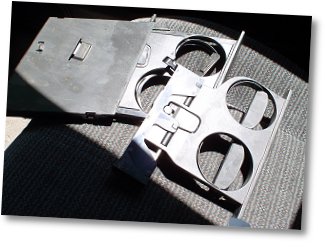 So I go with one of my friends junkyarding today to look for a Honda Accord wheel (crazy 4x114 lug pattern or something), and as I walk to the Imports section of U-Wrench-It, right there, jacked up and sitting on the outside row is a 1997 Subaru Legacy L wagon, red. It's rare to see a car that new at a junkyard, even more so a Subaru. It's parts time! I grab some parts I've wanted since I bought the car, like a light panel for the trunk, a fuel door release handle to replace my cracked one, and a front dual cupholder to replace the broken one in mine. That was only a $3 adventure. Then I started to stock up on luxuries - like a folding driver's side mirror (mine is non-folding), but the passenger one is already gone. The lights are all burned out on my HVAC controls, and it's missing a knob and buttons don't stick like they should - so I figured I might as well grab that out of there too.
So I go with one of my friends junkyarding today to look for a Honda Accord wheel (crazy 4x114 lug pattern or something), and as I walk to the Imports section of U-Wrench-It, right there, jacked up and sitting on the outside row is a 1997 Subaru Legacy L wagon, red. It's rare to see a car that new at a junkyard, even more so a Subaru. It's parts time! I grab some parts I've wanted since I bought the car, like a light panel for the trunk, a fuel door release handle to replace my cracked one, and a front dual cupholder to replace the broken one in mine. That was only a $3 adventure. Then I started to stock up on luxuries - like a folding driver's side mirror (mine is non-folding), but the passenger one is already gone. The lights are all burned out on my HVAC controls, and it's missing a knob and buttons don't stick like they should - so I figured I might as well grab that out of there too.
Picture - The "new" cupholder from the 97 Legacy features a different design than the 98 - instead of a slanted track, it springs to the right after you pop it out with the button, so it allows easier driver access to radio and HVAC controls.
Monday, 19th of May, 2003
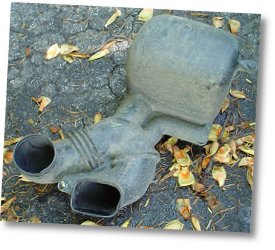 Joe and I decided it was time to remove the intake silencers from our Subarus and shorten and remove bends from the intake path. These silence snorkel apparatuses are huge! We start with my car since the fender liner is already off, and removal seemed to be easier.
Joe and I decided it was time to remove the intake silencers from our Subarus and shorten and remove bends from the intake path. These silence snorkel apparatuses are huge! We start with my car since the fender liner is already off, and removal seemed to be easier.
Picture - Removal was very easy. Three bolts and it was off. With the silencer and fender liner removed, you can see straight through the fender hole! But when I started the car, it would lope around when idling, and then sputter and die. Thinking it might be the ECU, we let that one sit with the positive terminal on the battery disconnected for a while. So we move on to Joe's 03 WRX while that one sits.
Picture - "WRX gives birth to intake silencer"! We had to jack up the corner of the car to let the wheel drop enough to access the plastic clips that hold the fender liner in place. Removing the hole thing would be too much trouble, we just loosened it enough to access the intake silencer. The top part was no problem, but there was one final nut that was quite difficult to get.
Picture - There was no room to stick the wrench in there and turn the nut. Joe decides the best way to access this nut is to remove the fog lamp. First we had to find a Phillips bit long enough to access it with our power screwdriver. That worked, though there was definitely no need to remove the top-right screw. Part of the power screwdriver also seemed to scrape against the bumper, taking off the paint... oops.
Picture - And the silencer is off! How does the fog light go back on again? Oh, right, you gotta bend back the plastic housing that got bent from letting the fog light hang like that. So we go and take it for a spin. The ECU had to figure things out, but by the end of the drive, all turbo lag was gone, you can hear the blow-off valve breathing, and it was overall an unbeatable mod - for free!
Picture - Now back to my car. Resetting the ECU did nothing. I must have knocked something off while pulling the silencer. I trace all the vaccuum hoses to see if they're still connected. Oh wow! The big fat one that connects the intake manifold to the middle of the intake tube was definitely off! Well let's fix that and go!
Picture - The pile of intake parts removed at the end of the day.
Picture - Now it's time to duct tape the holes in the fender left from the silencers, and we're good to roll!
The end product on my car after the ECU settled down is nice too. Overall, it's easier to deliver smooth power across the power band (there's more of it it seems), and above 3800 rpm, it's a noisemaker. There's a sweet spot around 2700 rpm where it blares out a nice solid tone, and at idle you can hear the rush of air by the hum it makes, which just further enhances its image as a spaceship.
Wednesday, 14th of May, 2003
- Picture - Oh No! My thoughts exactly when I saw this car.
Monday, 12th of May, 2003
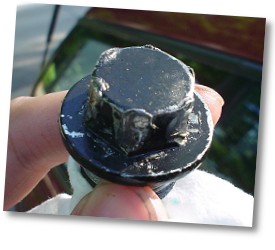 So here's the saga of my oil pan's drain bolt: I decide I to do an oil change 2 weeks ago, but I couldn't get the bolt loose with my open-end wrench. I was literally yanking on it with all my weight and then it started stripping. I tried liquid wrench, but that didn't help any. Seeing that I had stripped it, I decided before I did anything I'd buy a new bolt. I ended up having to wait a week for that to come in at the Lou Fusz Subaru parts department. Finally having the time to pick up the bolt today, I give it another shot, this time with a pipe wrench. I end up stripping it more, totally beyond use. I ended up calling Blaise, since he has a 17mm socket and a 3-foot long breaker bar known as an exhaust pipe. Brought it over, hammered on the socket since it didn't fit the stripped bolt anymore, and the torque of the long exhaust pipe was enough to loosen it. Never again taking my car to Midas, where they torque/hammer/weld the drain bolt into the oil pan.
So here's the saga of my oil pan's drain bolt: I decide I to do an oil change 2 weeks ago, but I couldn't get the bolt loose with my open-end wrench. I was literally yanking on it with all my weight and then it started stripping. I tried liquid wrench, but that didn't help any. Seeing that I had stripped it, I decided before I did anything I'd buy a new bolt. I ended up having to wait a week for that to come in at the Lou Fusz Subaru parts department. Finally having the time to pick up the bolt today, I give it another shot, this time with a pipe wrench. I end up stripping it more, totally beyond use. I ended up calling Blaise, since he has a 17mm socket and a 3-foot long breaker bar known as an exhaust pipe. Brought it over, hammered on the socket since it didn't fit the stripped bolt anymore, and the torque of the long exhaust pipe was enough to loosen it. Never again taking my car to Midas, where they torque/hammer/weld the drain bolt into the oil pan.
Sunday, 11th of May, 2003
- Picture - Nothing like transporting a door panel (which I will be using as my desk in my new room) by ramping it up the back of my wagon up onto the backs of the front seats. Makes driving with it kind of interesting though.
 Saturday, 10th of May, 2003
Saturday, 10th of May, 2003
- They're tearing down the housing projects near Powell Hall... watching the wrecking ball eat away at the building is pretty cool.
Friday, 9th of May, 2003
- Picture - If you thought the construction machine @ WU had a bad fall due to soil erosion, check out this machine at the intersection of I-170 and I-270. Yikes!
Thursday, 8th of May, 2003
- Picture - Is it a smart idea to build a new traffic light through the existing one?
Tuesday, 6th of May, 2003

- Photo journal of one of today's activities:
Photo - I was able to pick up some WRX wheels with Bridgestone Potenza RE92s on them, 205/55 16 with only 500 miles of highway use for $300 last night. I love how nicely things fit in a wagon!
Photo - It started raining! Hannah's grandmother let us use her big garage though (and Hannah took pictures too!) and so I decided to install these tonight.
Photo - I started with the rear wheels. I had to jump on the little 1' lug wrench they give us Subaru owners for the lug nuts to come off - looks like Lou Fusz Subaru overtorqued my steel wheels last week. Argh! But it's not a big deal, 2 wheels in 15 minutes.
Photo - 65 ft-lbs. Gotta make sure the new lug nuts on the new wheels are torqued correctly!
Photo - The front ones were even worse. I jumped on one of them so hard that I started stripping it. Time to use the good 'ol trick of rolling the car around a little and then try again. Finally it worked. Took more than 15 minutes though.
Photo - Great! All done. Wait a minute... the little scissors jack is stuck to the car...
Photo - The final product. Looks good! Btw, the flash on my Sony camera doesn't mess up the colours! I like that!
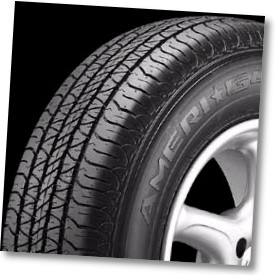 Now that I've put 8000 miles on the 185/70 14 General Ameri-G4S All-seasons, it's time to evaluate how they've been, because it's worth talking about. At $39 a tire on Tirerack, they're the cheapest tires one can get. So what DOES one get? Well, being so skinny, a good snow tire! All the snow storms we had this winter on the new tread and AWD was definitely superior to the normal all-season tire. They get a lot more traction than the BFG Radial T/As on Dad's Impreza. The other good point - a good rally tire! Went to a Rallycross event back in April and I was able to pendulum turn and drift just like the pros, it was excellent. Now what about normal street use? Well, they can handle up to 44psi, so that allows one to stiffen things up a little more than the usual flexible all-season tires for some autocrossing, which I did. Autocrossing definitely put away all hopes of seeing the benefits of a tire with the UTQG treadwear rating of 520. Two autocrossing schools later and a rotation in between and we're seeing about 40% of the tread gone. Dry traction leaves much to be desired - I couldn't decide on the proper pressure for street use - at factory 32/30 pressures, the tires would squeal at the slightest normal maneuver. Once you get about 38 psi, I could engage ABS on perfectly dry pavement. Not a good sign. The tires are also very noisy, worse than anything I've ever encountered, but ride is pretty normal, nothing unusual about that. Rain traction is better than average though, which is pretty nice for a $39 tire.
Now that I've put 8000 miles on the 185/70 14 General Ameri-G4S All-seasons, it's time to evaluate how they've been, because it's worth talking about. At $39 a tire on Tirerack, they're the cheapest tires one can get. So what DOES one get? Well, being so skinny, a good snow tire! All the snow storms we had this winter on the new tread and AWD was definitely superior to the normal all-season tire. They get a lot more traction than the BFG Radial T/As on Dad's Impreza. The other good point - a good rally tire! Went to a Rallycross event back in April and I was able to pendulum turn and drift just like the pros, it was excellent. Now what about normal street use? Well, they can handle up to 44psi, so that allows one to stiffen things up a little more than the usual flexible all-season tires for some autocrossing, which I did. Autocrossing definitely put away all hopes of seeing the benefits of a tire with the UTQG treadwear rating of 520. Two autocrossing schools later and a rotation in between and we're seeing about 40% of the tread gone. Dry traction leaves much to be desired - I couldn't decide on the proper pressure for street use - at factory 32/30 pressures, the tires would squeal at the slightest normal maneuver. Once you get about 38 psi, I could engage ABS on perfectly dry pavement. Not a good sign. The tires are also very noisy, worse than anything I've ever encountered, but ride is pretty normal, nothing unusual about that. Rain traction is better than average though, which is pretty nice for a $39 tire.
So in summary, it's a good tire for it's size - can't do much with 185-wide of tire, and they did a good job in making it perform well in rain, snow, and dirt. And for now, they're off the car, and I have All-seasons on my new wheels, so I might not even swap the Generals back on for the winter - but I don't think the RE92s will last for more than a year.
Monday, 5th of May, 2003
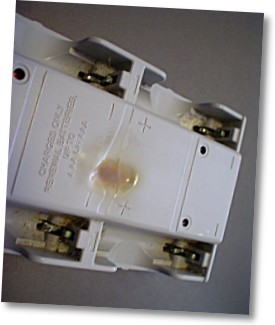 I've been a big fan of the Rayovac "Renew" rechargable Alkaline batteries for many years now. As a heavy user of things like PDAs, CD players, portable radios, and cameras, I end up saving lots of money by using rechargables. Unlike NiCd batteries, they also last a little longer and provide true 1.5V of power. NiCd batteries' 1.2V cells can damage electronics. The first battery charger I've ever had, which I got back in 1995, has lasted quite a while. It has a tendency to overheat itself and cause some batteries to leak every now and then ever since I got it, though. The plastic melted down to brown has been there since 1997, and there's quite a buildup of battery acide over the battery compartments over the years. Well, last week, it finally stopped working, after it exploded its last battery and just went dead. I took that opportunity to take it apart to see how it really worked and what overheats all the time. Not surprisingly, it's a pretty simple device.
I've been a big fan of the Rayovac "Renew" rechargable Alkaline batteries for many years now. As a heavy user of things like PDAs, CD players, portable radios, and cameras, I end up saving lots of money by using rechargables. Unlike NiCd batteries, they also last a little longer and provide true 1.5V of power. NiCd batteries' 1.2V cells can damage electronics. The first battery charger I've ever had, which I got back in 1995, has lasted quite a while. It has a tendency to overheat itself and cause some batteries to leak every now and then ever since I got it, though. The plastic melted down to brown has been there since 1997, and there's quite a buildup of battery acide over the battery compartments over the years. Well, last week, it finally stopped working, after it exploded its last battery and just went dead. I took that opportunity to take it apart to see how it really worked and what overheats all the time. Not surprisingly, it's a pretty simple device.

Thursday, 1st of May, 2003
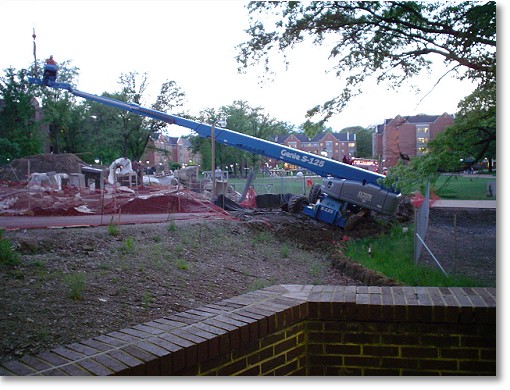
Progress on the new dormitories was slightly hindered today when heavy rains from the past few days caused the soil to become loose on a pathway used for transporting construction equipment...
It just sank deeper and deeper.
Towing it out was one major operation.
#Don't build your house on the sandy land...

